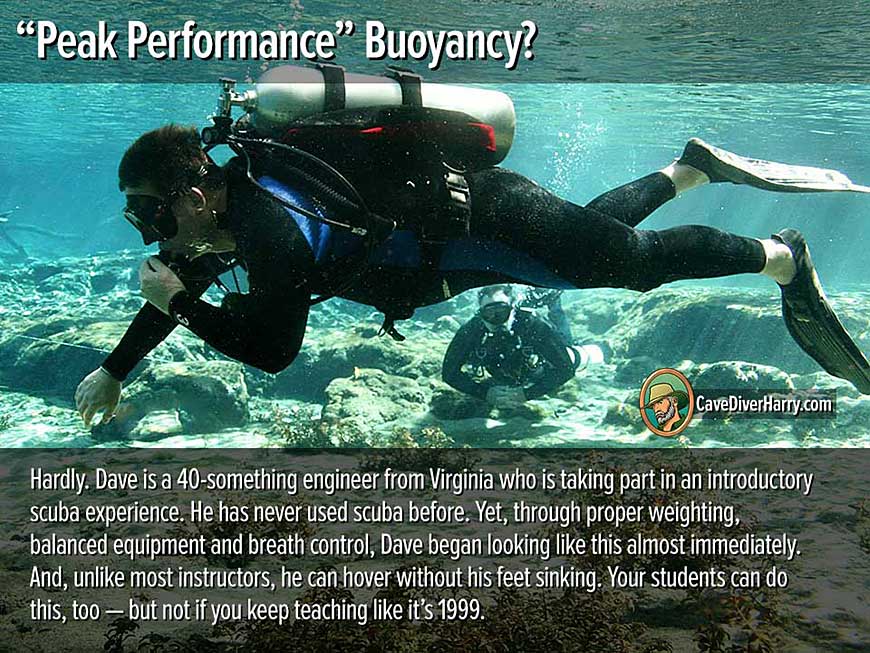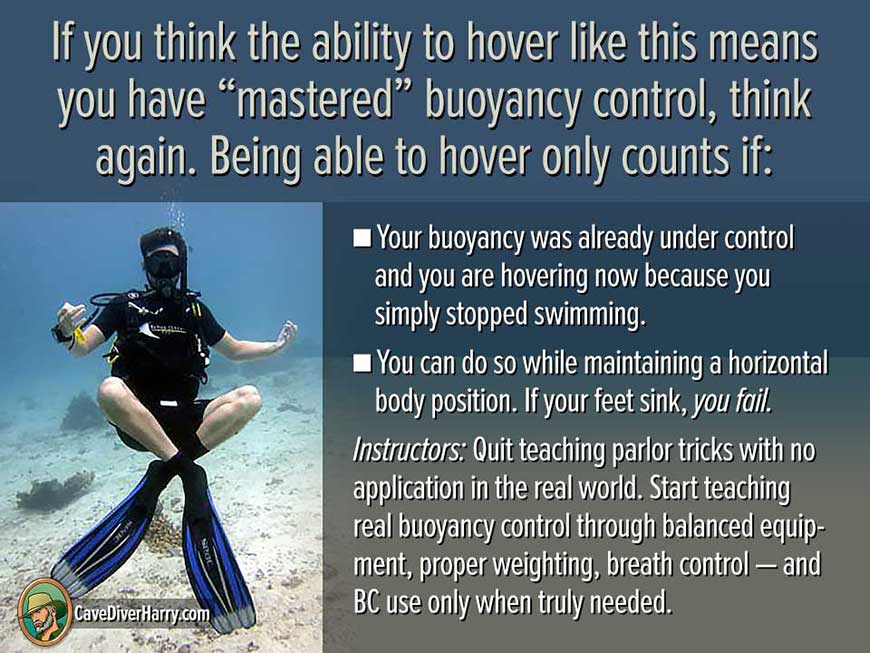 Go to Google Images. Search for Neutral Buoyancy. Along with images of the NASA Neutral Buoyancy facility and Neutral Buoyancy Turtle, you’ll see a lot of photos like the one on the right. To most divers — and, sadly, most instructors — the so-called Buddha Hover is synonymous with buoyancy control. Unfortunately, as Penn and Teller would say, it’s total bullshit. And here are seven reasons why.
Go to Google Images. Search for Neutral Buoyancy. Along with images of the NASA Neutral Buoyancy facility and Neutral Buoyancy Turtle, you’ll see a lot of photos like the one on the right. To most divers — and, sadly, most instructors — the so-called Buddha Hover is synonymous with buoyancy control. Unfortunately, as Penn and Teller would say, it’s total bullshit. And here are seven reasons why.
- It responds to a problem rather than solving it: Buddha hovers exist primarily because most entry-level students learn in equipment that is so egregiously out of balance, their feet can’t help but sink, making it all but impossible to hover any other way. Get students in balanced equipment and they should have little difficulty maintaining horizontal trim.
- It’s unrealistic: Hovering like Buddha is simply not something divers do in real life. It’s not even a good developmental skill, as most divers start this exercise negative and return to being negative when done, rather than transitioning to a more horizontal body position.
- It wastes time: In-water time in today’s scuba courses is far too limited as it is. Spending time teaching “skills” that bear no resemblance to real-life diving is time that could be spend practicing skills and abilities that do.

- It’s unnecessary: If you are teaching real buoyancy control by getting students in balanced equipment, using only the right amount of weight, allowing students to learn breath control and using BCs only to compensate for suit compression, you won’t need to do “skills” like fin pivots and Buddha hovers. Hovering will be something that happens automatically when students are neutral and simply stop kicking. And they will do it while maintaining horizontal trim.

- It makes things unnecessarily difficult: Learning good buoyancy control habits can actually be easy when combined with balanced equipment, proper weighting and breath control. Unfortunately, most students have to practice Buddha hovers while overweighted and in equipment that makes their feet sink. That’s hard to do. It’s as though your parents decided that, because maintaining balance is an integral part of riding a bike, you first needed to practice staying balanced on a bike that wasn’t moving. Ugh!
- It conveys the wrong message: Students who learn to control buoyancy by doing “skills” like fin pivots and Buddha hovers tend to come away thinking that buoyancy control is an unnecessarily complicated process that chiefly involves pushing buttons on a BC. BC use is important, but it’s only one element of a process that includes balanced equipment, proper weighting, breath control and active diver involvement. Students who understand this, and who are given the opportunity to practice all of the elements of buoyancy control, are seldom stymied by it.

- It teaches neutral buoyancy as a “skill” rather than as a habit: You can’t teach buoyancy control by having students practice one or two “skills” that bear only passing resemblance to real buoyancy control — especially if they spend the balance of their time standing, sitting or kneeling on the bottom. To teach real buoyancy control, you need to make it a habit students practice automatically, like breathing continuously and equalizing pressure on descent.
The bottom line is that Buddha hovers, like fin pivots, are total bullshit. They’re unnecessary, unrealistic, waste time and send students a horrible message. The irony is that, if you take time to read your training agency’s most current standards, you will likely discover they aren’t even required.
Stop teaching buoyancy control bullshit. Teach the five elements of real buoyancy control instead.
